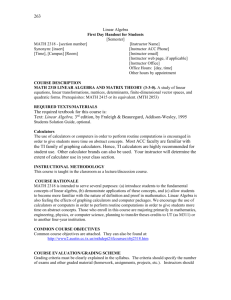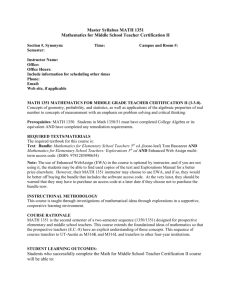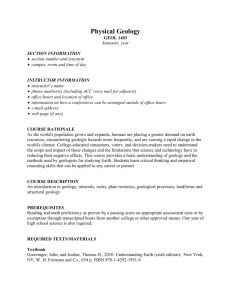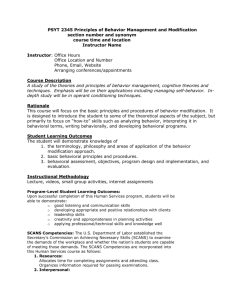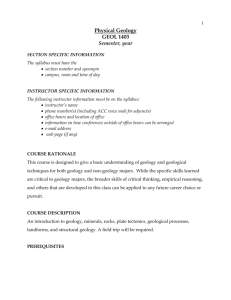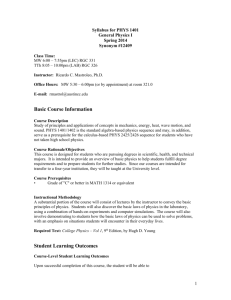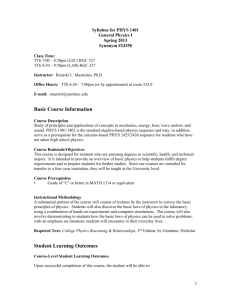Instructors are encouraged to add a statement of variance, such as
advertisement
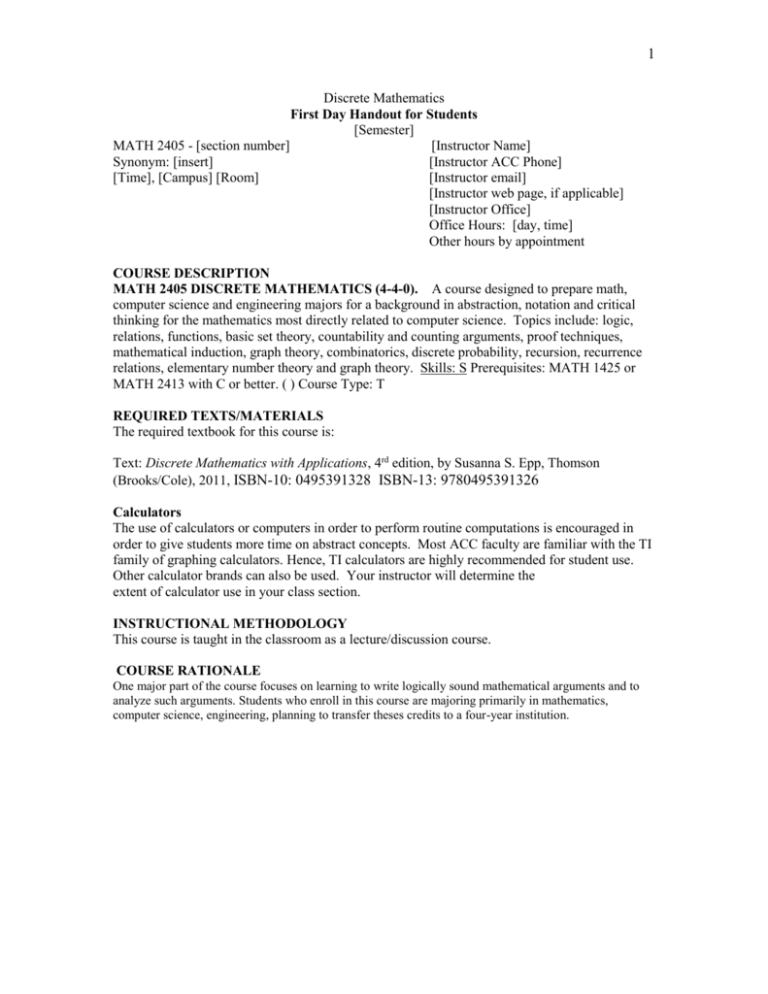
1 Discrete Mathematics First Day Handout for Students [Semester] MATH 2405 - [section number] [Instructor Name] Synonym: [insert] [Instructor ACC Phone] [Time], [Campus] [Room] [Instructor email] [Instructor web page, if applicable] [Instructor Office] Office Hours: [day, time] Other hours by appointment COURSE DESCRIPTION MATH 2405 DISCRETE MATHEMATICS (4-4-0). A course designed to prepare math, computer science and engineering majors for a background in abstraction, notation and critical thinking for the mathematics most directly related to computer science. Topics include: logic, relations, functions, basic set theory, countability and counting arguments, proof techniques, mathematical induction, graph theory, combinatorics, discrete probability, recursion, recurrence relations, elementary number theory and graph theory. Skills: S Prerequisites: MATH 1425 or MATH 2413 with C or better. ( ) Course Type: T REQUIRED TEXTS/MATERIALS The required textbook for this course is: Text: Discrete Mathematics with Applications, 4rd edition, by Susanna S. Epp, Thomson (Brooks/Cole), 2011, ISBN-10: 0495391328 ISBN-13: 9780495391326 Calculators The use of calculators or computers in order to perform routine computations is encouraged in order to give students more time on abstract concepts. Most ACC faculty are familiar with the TI family of graphing calculators. Hence, TI calculators are highly recommended for student use. Other calculator brands can also be used. Your instructor will determine the extent of calculator use in your class section. INSTRUCTIONAL METHODOLOGY This course is taught in the classroom as a lecture/discussion course. COURSE RATIONALE One major part of the course focuses on learning to write logically sound mathematical arguments and to analyze such arguments. Students who enroll in this course are majoring primarily in mathematics, computer science, engineering, planning to transfer theses credits to a four-year institution. 2 Learning Outcomes Upon successful completion of this course, students will: 1. Construct mathematical arguments using logical connectives and quantifiers. 2. Verify the correctness of an argument using propositional and predicate logic and truth tables. 3. Demonstrate the ability to solve problems using counting techniques and combinatorics in the context of discrete probability. 4. Solve problems involving recurrence relations and generating functions. 5. Use graphs and trees as tools to visualize and simplify situations. 6. Perform operations on discrete structures such as sets, functions, relations, and sequences. 7. Construct proofs using direct proof, proof by contraposition, proof by contradiction, proof by cases, and mathematical induction. 8. Apply algorithms and use definitions to solve problems and prove statements in elementary number theory. The course will cover sections from the following chapters in order to meet the outcomes above: Chapter 1: variables, the language of sets, the language of relations and functions. Chapter 2: logical form and logical equivalence, conditional statements, valid and invalid arguments, digital logic circuits. Chapter 3: introduction to predicates and quantified statements, multiple quantifiers and arguments with quantifiers. Chapter 4: direct proof and counterexample with existential and universal statements, with rational numbers, with divisibility, with division into cases. Chapter 6: basic definitions of set theory. Chapter 8: relations on sets, reflexivity, symmetry and transitivity, equivalence relations. Chapter 9: counting and discrete probability, expected value, conditional probability, Bayes’ theorem, independent events. Chapter 7: functions defined on general sets, one-to-one, onto, inverse functions. Chapter 11: the Big O, Big Theta and Big Omega. Chapter 5: sequences and mathematical induction, recursively defined sequences, solving recurrence relation by iteration. Chapter 10: introduction to graph theory. 3 Course Objectives (by topic) 1. General Objectives: Throughout the course, students will be expected to demonstrate their understanding of Discrete Mathematics by being able to do each of the following: 1.1 The main objective of the course is to introduce the student to the concept of "proof" applied in different settings. 1.2 Use mathematically correct terminology and notation. 1.3 Discuss definitions and diagram strategies for potential proofs in logical sequential order without mathematical symbols (plain English). 1.4 Construct direct, indirect proofs and provide strategies for division into cases. 1.5 Use counterexamples. 1.6 Apply logical reasoning to solve a variety of problems. 2. Propositional Logic 2.1 Write English sentences for logical expressions and vice-versa. Use standard notations of propositional logic. 2.2 Complete and use truth tables for expressions involving the following logical connectives: negation, conjunction, disjunction, conditional, and biconditional. 2.3 Define and use the terms: proposition (statement), converse, inverse, contrapositive, tautology, and contradiction. 2.4 Apply standard logical equivalences. Be able to prove that two logical expressions are or are not logically equivalent. 2.5 Determine if a logical argument is valid or invalid by tables or trees. Apply standard rules of inference including (but not limited to) Modus Ponens, Modus Tollens, Transitivity, and Elimination. Recognize fallacies such as the Converse Error and the Inverse Error. 3. Predicate Logic 3.1 Translate between English sentences and symbols for universally and existentially quantified statements, including statements with multiple quantifiers. 3.2 Write the negation of a quantified statement involving either one or two quantifiers. 3.3 Determine if a quantified statement involving either one or two quantifiers is true or false. 4. Elementary Number Theory 4.1 Construct correct direct and indirect (contradiction and contraposition) proofs involving concepts from elementary number theory such as even and odd integers, rational and irrational numbers, and divisibility. Floor and ceiling. 4.2 Find a counterexample to show that a proposed statement involving concepts from elementary number theory is false. 4.3 State and use the Quotient-Remainder Theorem (Division Algorithm) and apply the mod, div, floor and ceiling for the proof of the Division Algorithm. 4.4 Apply the Euclidean Algorithm. 5. Mathematical Induction 5.1 State the Principle of Mathematical Induction. 5.2 Construct induction proofs involving summations, inequalities, divisibility arguments, counting arguments, recurrence relation correctness and incorrectness. 6. Set Theory 6.1 Use set notation, including the notations for subsets, unions, intersections, differences, complements, cross (Cartesian) products, and power sets. 6.2 Prove that a proposed statement involving sets is true, or give a counterexample to show that it is false. In particular, be able to prove that a set is empty. 4 7. Combinatorics 7.1 Solve counting problems involving the multiplication rule, permutations, and combinations (with and without replacement). Use standard notation. 7.2 Apply the Addition Rule and the Principle of Inclusion and Exclusion. 7.3 Use Pascal’s formula and Pascal’s Triangle. 7.4 Apply the Binomial Theorem. 7.5 Apply the Pigeonhole Principle. 7.6 Use the basic ideas of discrete probability. Binomial Distribution. Geometric Distribution. Expected Values. Bayes’ Rule. 8. Functions 8.1 Define and use the terms function, domain, codomain, range, image, inverse image and composition. 8.2 State the definitions of one-to-one functions (injections), onto functions (surjections), and one-to-one correspondences (bijections). Determine which of these characteristics is associated with a given function. 8.3 Prove that a given function is one-to-one, or give a counterexample to show that it is not. 8.4 Prove that a given function is onto, or give a counterexample to show that it is not. 8.5 Describe the connection between bijective functions and inverses. Be able to find the inverse of an invertible function. 8.6 Find and prove a big-O estimate of growth for a given function. 9. Relations 9.1 State the definitions of binary relation, reflexive, symmetric, transitive, equivalence relation, equivalence class, class representative, and partition. 9.2 Show that a binary relation on a set is an equivalence relation, or give a counterexample to show that it is not. 9.3 Given an equivalence relation on a set, find the equivalence classes of the relation and show that they form a partition of the set. 9.4 Show that congruence modulo m is an equivalence relation on the integers, and that congruence classes modulo m form a partition of the integers. 9.5 Sequences. Recursive Relations. Solution by Iteration. Check Correctness by Induction. First Order Difference Equations. Second Order Difference Equations. 5 COURSE CALENDAR/OUTLINE Week 1 2 3 4 5 6 7 8 9 10 11 12 13 14 15 16 16-Week Semester Sections 1.1, 1.2, 1.3, 2.1 2.2, 2.3, 2.4 2.5, 3.1, 3.2 3.3, 3.4, 4.1 4.2, 4.3, 4.4 4.5, 4.6 4.7, 4.8, 6.1 6.2, 8.1, 8.2 8.3, 5.2 9.1, 9.2, 9.3 9.4, 9.5, 9.7 9.8, 9.9, 7.1 7.2, 7.3, 7.4, 11.1 11.2, 5.1, 5.3 5.6, 5.7, 5.8 10.1 Review, Final Test Instructors are encouraged to add a statement of variance, such as “Please note: schedule changes may occur during the semester. Any changes will be announced in class.” Required Time: You cannot learn abstract concepts in math by listening to someone talk about it. You learn mathematics by thinking about and working on proofs and computational questions. And this takes time. If you allow yourself plenty of time to think about the material, you will find it much more interesting and enjoyable. A reasonable amount of time (for any college class, but especially for math) is three hours outside of class for every hour in class. You have made up your schedule this semester to include your classes at certain times every week. You should now include on that schedule certain regular hours for study—three hours of study for each hour you are in class. If you do not do this, you will not do as well in school as you are capable of, and you will find it more frustrating than it should be. Course-specific support services: ACC main campuses have Learning Labs which offer free first-come first-serve tutoring in various courses. Students should bring their text, course handouts, and notes when they come to the Learning Lab. The locations, contact information and hours of availability of the Learning Labs are available from http://www.austincc.edu/tutor ” Not all math tutors can tutor discrete math, so look at the schedule in the learning lab carefully to see when discrete math tutors are available. Course Evaluation/Grading Scheme: Grading criteria must be clearly explained in the syllabus. The criteria should specify the number of exams and other graded material (homework, assignments, projects, etc.). Instructors should discuss the format and administration of exams Guidelines for other graded materials, such as homework or projects, should also be included in the syllabus. 6 Course Policies The syllabus should contain the following policies of the instructor, as well as the policies below: missed exam policy about late work (if applicable) attendance policy Comment: The general statement below from the college seems less specific than is useful in our classes. Write something that reflects your expectations to add to the statement below. Here’s one suggestion: “In this class, missing more than 10% of the class time over the semester is considered unsatisfactory. That is approximately four classes of a class which meets two days a week in the 16-week semester.” class participation expectations reinstatement policy (if applicable) Comment: If the instructor chooses to allow reinstatements, he must include a statement about the circumstances under which is it allowed. One possible statement is: “In order to be reinstated, the student must demonstrate that he is caught up with the required work as of the date on which he wishes to be reinstated. This must be done before the official last date to withdraw for the semester.” Attendance/Class Participation: Regular and punctual class attendance is expected of all students. If attendance or compliance with other course policies is unsatisfactory, the instructor may withdraw students from the class. Withdrawal Policy: It is the responsibility of each student to ensure that his or her name is removed from the roll should he or she decide to withdraw from the class. The instructor does, however, reserve the right to drop a student should he or she feel it is necessary. If a student decides to withdraw, he or she should also verify that the withdrawal is submitted before the Final Withdrawal Date. The student is also strongly encouraged to retain their copy of the withdrawal form for their records. This semester is ___________ and the Final Withdrawal Date for this class is ________________. http://www.austincc.edu/support/admissions/registrationcalendar.php Students who enroll for the third or subsequent time in a course taken since Fall 2002 may be charged a higher tuition rate for that course. State law permits students to withdraw from no more than six courses during their entire undergraduate career at Texas public colleges or universities. With certain exceptions, all course withdrawals automatically count towards this limit. Details regarding this policy can be found in the ACC college catalog. Incomplete Grades: Incomplete grades will be given only in very rare circumstances. Generally, to receive a grade of “I”, a student must have taken all examinations, be passing, and after the last date to withdraw, have a personal tragedy occur which prevents course completion. An incomplete grade cannot be carried beyond the established date in the following semester. The completion date is determined by the instructor but may not be later than the final deadline for withdrawal in the subsequent semester. 7 Statement on Scholastic Dishonesty: A student attending ACC assumes responsibility for conduct compatible with the mission of the college as an educational institution. Students have the responsibility to submit coursework that is the result of their own thought, research, or selfexpression. Students must follow all instructions given by faculty or designated college representatives when taking examinations, placement assessments, tests, quizzes, and evaluations. Actions constituting scholastic dishonesty include, but are not limited to, plagiarism, cheating, fabrication, collusion, and falsifying documents. Penalties for scholastic dishonesty will depend upon the nature of the violation and may range from lowering a grade on one assignment to an “F” in the course and/or expulsion from the college. See the Student Standards of Conduct and Disciplinary Process and other policies at http://www.austincc.edu/current/needtoknow Student Rights and Responsibilities: Students at the college have the rights accorded by the U.S. Constitution to freedom of speech, peaceful assembly, petition, and association. These rights carry with them the responsibility to accord the same rights to others in the college community and not to interfere with or disrupt the educational process. Opportunity for students to examine and question pertinent data and assumptions of a given discipline, guided by the evidence of scholarly research, is appropriate in a learning environment. This concept is accompanied by an equally demanding concept of responsibility on the part of the student. As willing partners in learning, students must comply with college rules and procedures. Statement on Students with Disabilities: Each ACC campus offers support services for students with documented disabilities. Students with disabilities who need classroom, academic or other accommodations must request them through the Office for Students with Disabilities (OSD). Students are encouraged to request accommodations when they register for courses or at least three weeks before the start of the semester, otherwise the provision of accommodations may be delayed. Students who have received approval for accommodations from OSD for this course must provide the instructor with the ‘Notice of Approved Accommodations’ from OSD before accommodations will be provided. Arrangements for academic accommodations can only be made after the instructor receives the ‘Notice of Approved Accommodations’ from the student. Students with approved accommodations are encouraged to submit the ‘Notice of Approved Accommodations’ to the instructor at the beginning of the semester because a reasonable amount of time may be needed to prepare and arrange for the accommodations. Additional information about the Office for Students with Disabilities is available at http://www.austincc.edu/support/osd/ Safety Statement: Austin Community College is committed to providing a safe and healthy environment for study and work. You are expected to learn and comply with ACC environmental, health and safety procedures and agree to follow ACC safety policies. Additional information on these can be found at http://www.austincc.edu/ehs. Because some health and safety circumstances are beyond our control, we ask that you become familiar with the Emergency Procedures poster and Campus Safety Plan map in each classroom. Additional information about emergency procedures and how to sign up for ACC Emergency Alerts to be notified in the event of a serious emergency can be found at http://www.austincc.edu/emergency/. You are expected to conduct yourself professionally with respect and courtesy to all. Anyone who thoughtlessly or intentionally jeopardizes the health or safety of another individual will be immediately dismissed from the day’s activity, may be withdrawn from the class, and/or barred from attending future activities. 8 Use of ACC email: All College e-mail communication to students will be sent solely to the student’s ACCmail account, with the expectation that such communications will be read in a timely fashion. ACC will send important information and will notify you of any college related emergencies using this account. Students should only expect to receive email communication from their instructor using this account. Likewise, students should use their ACCmail account when communicating with instructors and staff. Instructions for activating an ACCmail account can be found at http://www.austincc.edu/accmail/index.php. Testing Center Policy: Under certain circumstances, an instructor may have students take an examination in a testing center. Students using the Academic Testing Center must govern themselves according to the Student Guide for Use of ACC Testing Centers and should read the entire guide before going to take the exam. To request an exam, one must have: 1. ACC Photo ID 2. Course Abbreviation (e.g., MATH) 3. Course Number (e.g.,1342) 4. Course Synonym (e.g., 10123) 5. Course Section (e.g., 005) 6. Instructor's Name Do NOT bring cell phones to the Testing Center. Having your cell phone in the testing room, regardless of whether it is on or off, will revoke your testing privileges for the remainder of the semester. ACC Testing Center policies can be found at http://www.austincc.edu/testctr/ Student and Instructional Services: ACC strives to provide exemplary support to its students and offers a broad variety of opportunities and services. Information on these services and support systems is available at: http://www.austincc.edu/s4/ Links to many student services and other information can be found at: http://www.austincc.edu/current/ ACC Learning Labs provide free tutoring services to all ACC students currently enrolled in the course to be tutored. The tutor schedule for each Learning Lab may be found at: http://www.autincc.edu/tutor/students/tutoring.php For help setting up your ACCeID, ACC Gmail, or ACC Blackboard, see a Learning Lab Technician at any ACC Learning
